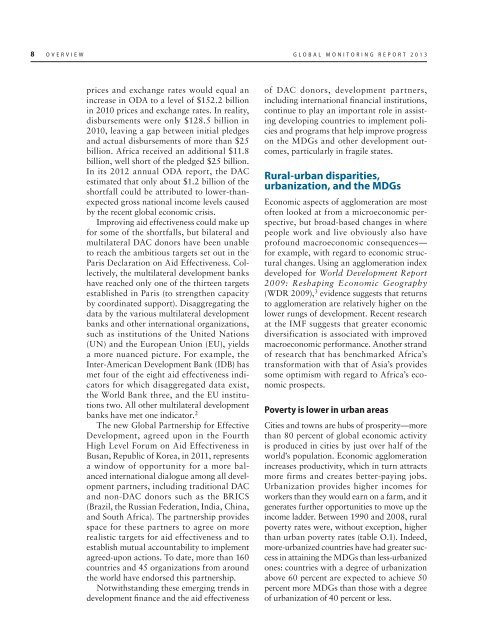rural-urban dynamics_report.pdf - Khazar University
rural-urban dynamics_report.pdf - Khazar University
rural-urban dynamics_report.pdf - Khazar University
You also want an ePaper? Increase the reach of your titles
YUMPU automatically turns print PDFs into web optimized ePapers that Google loves.
8 OVERVIEW GLOBAL MONITORING REPORT 2013<br />
prices and exchange rates would equal an<br />
increase in ODA to a level of $152.2 billion<br />
in 2010 prices and exchange rates. In reality,<br />
disbursements were only $128.5 billion in<br />
2010, leaving a gap between initial pledges<br />
and actual disbursements of more than $25<br />
billion. Africa received an additional $11.8<br />
billion, well short of the pledged $25 billion.<br />
In its 2012 annual ODA <strong>report</strong>, the DAC<br />
estimated that only about $1.2 billion of the<br />
shortfall could be attributed to lower-thanexpected<br />
gross national income levels caused<br />
by the recent global economic crisis.<br />
Improving aid effectiveness could make up<br />
for some of the shortfalls, but bilateral and<br />
multilateral DAC donors have been unable<br />
to reach the ambitious targets set out in the<br />
Paris Declaration on Aid Effectiveness. Collectively,<br />
the multilateral development banks<br />
have reached only one of the thirteen targets<br />
established in Paris (to strengthen capacity<br />
by coordinated support). Disaggregating the<br />
data by the various multilateral development<br />
banks and other international organizations,<br />
such as institutions of the United Nations<br />
(UN) and the European Union (EU), yields<br />
a more nuanced picture. For example, the<br />
Inter-American Development Bank (IDB) has<br />
met four of the eight aid effectiveness indicators<br />
for which disaggregated data exist,<br />
the World Bank three, and the EU institutions<br />
two. All other multilateral development<br />
banks have met one indicator. 2<br />
The new Global Partnership for Effective<br />
Development, agreed upon in the Fourth<br />
High Level Forum on Aid Effectiveness in<br />
Busan, Republic of Korea, in 2011, represents<br />
a window of opportunity for a more balanced<br />
international dialogue among all development<br />
partners, including traditional DAC<br />
and non-DAC donors such as the BRICS<br />
(Brazil, the Russian Federation, India, China,<br />
and South Africa). The partnership provides<br />
space for these partners to agree on more<br />
realistic targets for aid effectiveness and to<br />
establish mutual accountability to implement<br />
agreed-upon actions. To date, more than 160<br />
countries and 45 organizations from around<br />
the world have endorsed this partnership.<br />
Notwithstanding these emerging trends in<br />
development finance and the aid effectiveness<br />
of DAC donors, development partners,<br />
including international financial institutions,<br />
continue to play an important role in assisting<br />
developing countries to implement policies<br />
and programs that help improve progress<br />
on the MDGs and other development outcomes,<br />
particularly in fragile states.<br />
Rural-<strong>urban</strong> disparities,<br />
<strong>urban</strong>ization, and the MDGs<br />
Economic aspects of agglomeration are most<br />
often looked at from a microeconomic perspective,<br />
but broad-based changes in where<br />
people work and live obviously also have<br />
profound macroeconomic consequences—<br />
for example, with regard to economic structural<br />
changes. Using an agglomeration index<br />
developed for World Development Report<br />
2009: Reshaping Economic Geography<br />
(WDR 2009), 3 evidence suggests that returns<br />
to agglomeration are relatively higher on the<br />
lower rungs of development. Recent research<br />
at the IMF suggests that greater economic<br />
diversification is associated with improved<br />
macroeconomic performance. Another strand<br />
of research that has benchmarked Africa’s<br />
transformation with that of Asia’s provides<br />
some optimism with regard to Africa’s economic<br />
prospects.<br />
Poverty is lower in <strong>urban</strong> areas<br />
Cities and towns are hubs of prosperity—more<br />
than 80 percent of global economic activity<br />
is produced in cities by just over half of the<br />
world’s population. Economic agglomeration<br />
increases productivity, which in turn attracts<br />
more firms and creates better-paying jobs.<br />
Urbanization provides higher incomes for<br />
workers than they would earn on a farm, and it<br />
generates further opportunities to move up the<br />
income ladder. Between 1990 and 2008, <strong>rural</strong><br />
poverty rates were, without exception, higher<br />
than <strong>urban</strong> poverty rates (table O.1). Indeed,<br />
more-<strong>urban</strong>ized countries have had greater success<br />
in attaining the MDGs than less-<strong>urban</strong>ized<br />
ones: countries with a degree of <strong>urban</strong>ization<br />
above 60 percent are expected to achieve 50<br />
percent more MDGs than those with a degree<br />
of <strong>urban</strong>ization of 40 percent or less.

















